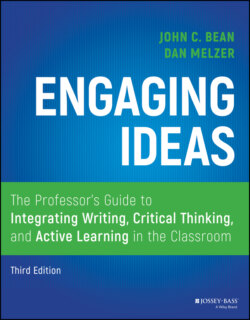Читать книгу Engaging Ideas - John C. Bean - Страница 29
1 Using Writing to Promote Thinking : A Busy Professor's Guide to the Whole Book
ОглавлениеIn his now classic study of pedagogical strategies that make a difference, Richard Light (2001) examined the connection between writing and student engagement. “The results are stunning,” he claims:
The relationship between the amount of writing for a course and students' level of engagement—whether engagement is measured by time spent on the course, or the intellectual challenge it presents, or students' level of interest in it—is stronger than the relationship between students' engagement and any other course characteristic. (55)
More recent research, conducted jointly by the National Survey of Student Engagement (NSSE) and the Council of Writing Program Administrators (WPA), has shown that for promoting engagement and deep learning the number of writing assignments in a course may not be as important as the design of the writing assignments themselves (Anderson, Anson, Gonyea, and Paine, 2009). Good assignments, this research has shown, give students opportunities to receive early feedback on their work, encourage meaning‐making, and clearly explain the instructor's expectations and purpose. (We discuss this research in depth in chapter 4.) The aim of this book is to give professors a wide range of options for bringing the benefits of engaged learning to students. Our premise, supported by an increasing body of research, is that good writing assignments (as well as other active learning tasks) evoke a high level of critical thinking, help students wrestle productively with a course's big questions, and teach disciplinary ways of seeing, knowing, and doing. They can also be designed to promote self‐reflection, leading to more integrated, personally meaningful learning. Moreover, the benefits do not accrue only to students. Professors who successfully integrate writing and other critical thinking activities into their courses often report a satisfying increase in their teaching pleasure: students are better prepared for class, discussions are richer, and student performance improves.
But the use of writing and critical thinking activities to promote learning does not happen through serendipity. Teachers must plan for it and foster it throughout the course. This chapter suggests a sequence of steps that teachers can take to integrate writing and critical thinking into their courses. It then addresses four negative beliefs that often discourage teachers from taking these steps—the beliefs that integrating writing into a course will take time away from content, that writing assignments are not appropriate for some disciplines or courses, that assigning writing will bury a teacher in paper grading, and that assigning writing requires specialized expertise. Because these beliefs raise important concerns, we seek to supply reassuring responses at the outset.
This chapter provides, in effect, a brief overview of the whole book; subsequent chapters treat in depth each of the suggestions or issues introduced briefly here.
